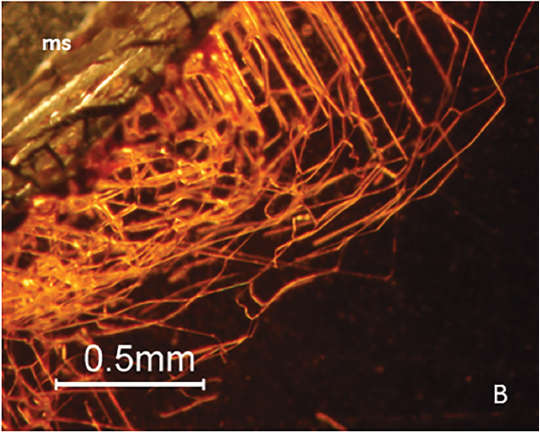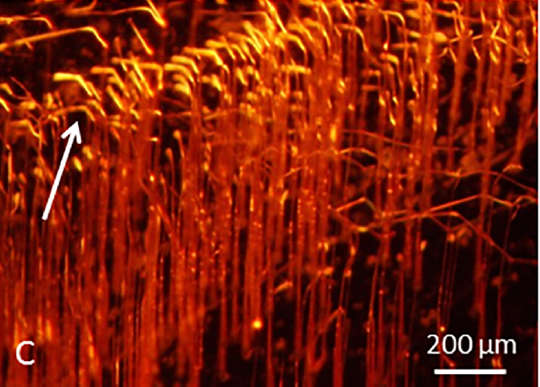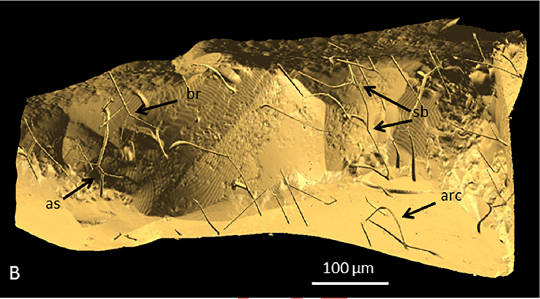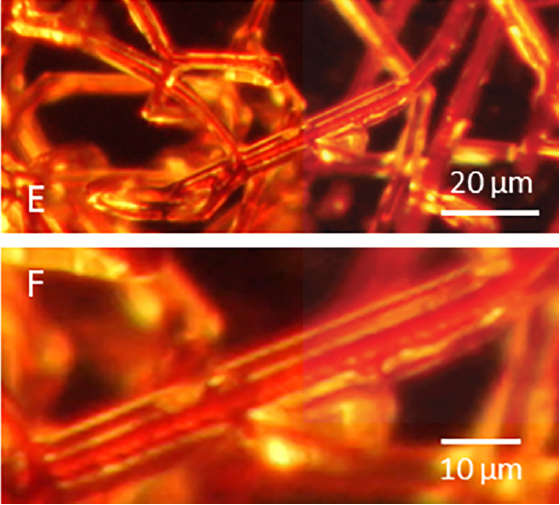This article was published in Scientific American’s former blog network and reflects the views of the author, not necessarily those of Scientific American
A garnet is not a soft stone. With a Mohs hardness of 7.5, the mineral resists both physical and chemical assault. In light of that, the garnets pulled from Thailand’s Chiang Mai River contain an intriguing puzzle: dozens of spidery tunnels.

ms = mineral surface. Credit: Ivarsson et al. 2018
To gem dealers, they are dismaying. They mar the gems’ clarity and spoil their profit. But to a team of Swedish and Thai scientists, who recently published their studies in the journal PLOS ONE, they were fascinating. What could be responsible for galleries whose shifting shapes and circuitous routes seem to defy their location in a gemstone as tough as hardened steel?
On supporting science journalism
If you're enjoying this article, consider supporting our award-winning journalism by subscribing. By purchasing a subscription you are helping to ensure the future of impactful stories about the discoveries and ideas shaping our world today.
Sometimes the tunnels run in parallel palisades, negotiating turns in tandem.

Arrow marks tunnel curvature. Credit: Ivarsson et al. 2018
Sometimes they curve without regard to one another. Sometimes they branch. Sometimes the branches fuse. Sometimes a tunnel enters the garnet and comes right back out again in a simple arc.

br = branching, sb= serial branching, as= anastomosis, arc= arc-shaped tunnel. Credit: Ivarsson et al. 2018
Sometimes the tunnels have round cross sections, particularly near the tips. Sometimes they are rectangular or hexagonal with much larger diameters, particularly near the gem’s surface. The orientation of these polygonal tunnels is usually identical in adjacent tunnels, suggesting their orientation is controlled by the planes of the garnet crystal.
But above all there were these three clues: every single tunnel had an exit hole at the gem’s surface. None of the garnets pulled from their source in granite host rock contained a single tunnel. And a few of the tunnels were stuffed with these reddish roundish filaments.

Credit: Ivarsson et al. 2018
The scientists considered many hypotheses.
The Chiang Mai River is calm, which rules out some sort of bizarre rock-tumbler effect.
Pyrope and almandine garnets can contain spiky inclusions of the minerals rutile or chrysotile, but they are normally more evenly distributed, and they do not curve or reach the crystal’s surface.
Three other physical processes can produce tunnels – ambient inclusion tunnels, fluid inclusion trails, and radiation damage trails -- but none of them resemble these tunnels.
The fact that the tunnels fuse with each other to form a network is, however, highly suggestive. This process, called anastomosis, is highly characteristic of life -- and one kingdom in particular.
A few years ago I wrote about the fact that the world’s largest mining operation is run by fungi. Both lichens and mycorrhizal fungi, a huge class of organisms that live cooperatively with plant roots, bore into rock using a combination of organic acids, metal-grabbing molecules called chelators, and mechanical force. The tip of a fungal filament is a biological drill bit, bearing down on the rock face with crushing pressure. Both types of fungi are after mineral nutrients, though lichens are also securing themselves to their home. Recently, fungi have also been discovered excavating the seafloor crust. If so, the sheer volume of such crust might make it, astoundingly, Earth’s largest fungal habitat.
Yet in spite of these discoveries, no one has ever observed fungi mining garnet or any other mineral harder than a Mohs 7. Nor have anastomosing tunnels or polygonal entrances been observed in fungal diggings previously.
The fact all tunnels have surface openings supports a biological agent, as do those telltale filaments still trapped inside. Complex organic fatty acid residues characteristic of life were detected inside but not outside the tunnels, nor in hematite and quartz controls from the same sediments. Because fungi can transport the tailings from their excavations to the outside via their own bodies, this would explain why the tunnels are not clogged with the “byproducts of mineral dissolution”.
Although bacteria have also been known to bore into rocks in search of iron and manganese, the size, shape and connectedness of the tunnels are consistent with the action of fungi but not with that of iron-oxidizing bacteria. Excavating fungi can also detect and follow chemical gradients within rock they are mining. This may explain the palisade-like appearance of many parallel tunnels, as the fungi chase the same nutrients like hounds scenting a fox. The fungi in the Chiang Mai River also have strong motive. Garnets are a source of usable iron. The sediments of the river are not.
The weight of the evidence thus suggests, the scientists say, that the garnet tunnels are the stopes, shafts, drifts, and adits of iron-starved river fungi, mining the garnets of the Chiang Mai not for adornment, but for their very survival.
Reference
Ivarsson, Magnus, Henrik Skogby, Bongkot Phichaikamjornwut, Stefan Bengtson, Sandra Siljeström, Prayote Ounchanum, Apichet Boonsoong et al. "Intricate tunnels in garnets from soils and river sediments in Thailand–Possible endolithic microborings."PloS One 13, no. 8 (2018): e0200351.